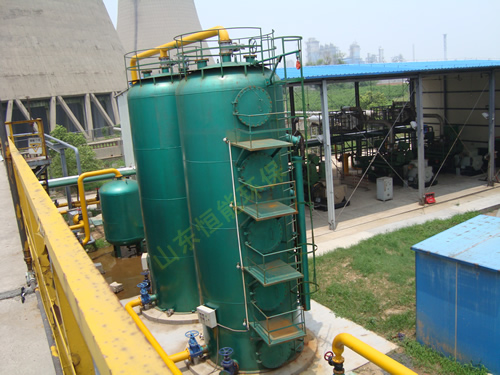歡迎進入山東恒能環保能源設備有限公司
歡迎進入山東恒能環保能源設備有限公司
硫化氫(H2S),一種具有臭雞蛋氣味的有毒惡臭氣體,在眾多工業活動中均有出現。生物處理被認為是處理這種惡臭氣體的最佳方法,主要因其低成本和高安全性。在眾多生物反應器中,生物滴濾池(BTF)因其可控的操作參數和易排出的代謝產物而備受關注。然而,生物反應器在運行中常遇到生物量過度積累導致的高壓降問題,這不僅增加能源消耗,還會降低反應器性能。傳統的生物量控制方法如高速水流沖洗、進氣負荷控制、營養元素供給和化學清洗,雖有效但成本較高且可能影響反應器恢復性能。本文的目的是探究pH值變化對脫硫生物反應器微生物群落結構的影響,分析不同pH范圍內的反應器性能和壓降變化,并提出利用pH控制生物量增長的策略,旨在提高脫硫性能并減少運營成本,以推動脫硫技術的發展和應用。圖文摘要BTF系統對H2S的長期去除性能如圖1所示。在階段I,BTF系統在中性偏堿性條件下運行(6.0<pH<9.5)。BTF在該階段獲得的對H2S的最大去除速率(ECmax)為246.5g/(m3·h)(去除率為82.8%);階段II是弱酸性運行階段(pH在2.6-5.5)。在該階段獲得的ECmax為142.8 g/(m3·h)(去除率為66.6%)。傳質阻力的增加和硫氧化菌(SOB)的活性降低是造成弱酸性時期脫硫性能下降主要原因;階段III為極酸性運行階段,在不添加堿性試劑的情況下,循環液的pH逐漸下降到1.0以下。BTF在該階段獲得的ECmax為164.6g/(m3·h)(去除率為65.0%)。極酸性時期的EC和SOB活性低于中性偏堿性時期,但明顯高于弱酸性時期。圖1 BTF在不同pH時期的長期運行效果
Hydrogen sulfide (H2S), a toxic and foul smelling gas with a foul egg odor, is present in many industrial activities. Biological treatment is considered the best method for treating this odorous gas, mainly due to its low cost and high safety. Among numerous bioreactors, the biological drip filter (BTF) has attracted much attention due to its controllable operating parameters and easy elimination of metabolites. However, bioreactors often encounter high pressure drop problems caused by excessive biomass accumulation during operation, which not only increases energy consumption but also reduces reactor performance. Traditional biomass control methods such as high-speed water flow flushing, intake load control, nutrient supply, and chemical cleaning are effective but costly and may affect reactor recovery performance. The purpose of this article is to explore the impact of pH changes on the microbial community structure of desulfurization bioreactors, analyze reactor performance and pressure drop changes within different pH ranges, and propose strategies for controlling biomass growth using pH, with the aim of improving desulfurization performance and reducing operating costs to promote the development and application of desulfurization technology. The long-term removal performance of the BTF system for H2S is shown in Figure 1. In Stage I, the BTF system operates under neutral to alkaline conditions (6.0<pH<9.5). The maximum removal rate (ECmax) of H2S obtained by BTF in this stage is 246.5g/(m3 · h) (removal rate of 82.8%); Stage II is the weakly acidic operating stage (pH between 2.6-5.5). The ECmax obtained at this stage is 142.8 g/(m3 · h) (removal rate of 66.6%). The increase in mass transfer resistance and the decrease in activity of sulfur oxidizing bacteria (SOBs) are the main reasons for the decline in desulfurization performance during weak acidic periods; Stage III is an extremely acidic operating stage, in which the pH of the circulating solution gradually decreases to below 1.0 without adding alkaline reagents. The ECmax obtained by BTF in this stage is 164.6 g/(m3 · h) (removal rate of 65.0%). The EC and SOB activities during the extremely acidic period are lower than those during the neutral alkaline period, but significantly higher than those during the weakly acidic period. Figure 1 Long term operation effect of BTF at different pH periods
圖2顯示了過濾床內生物量和壓降(ΔP)的變化。生物量和ΔP在堿性運行時期迅速增長。隨著pH降低至弱酸性范圍內,在沒有進行曝氣沖洗的前提下,生物量和ΔP開始呈現出降低的趨勢。當循環液pH降低至1以下(極酸性時期),生物量和ΔP進一步下降至10-11g/L和99-117Pa/m,并長期維持在該水平。圖2 過濾床內生物量和ΔP變化圖3顯示了各時期生物膜菌群結構變化。在中性偏堿性時期,BTF系統中富集到的微生物主要為耐堿和耐鹽的異養菌,如Pseudomonas、Stenotrophomonas、Brevundimonas、Halomonas、Brucella和Evansella。在弱酸性階段,這一時期的大多數細菌是輕度嗜酸的SOB,如Acidithiobacillus、Metallibacterium、Thiomonas和Acidiphilium等。一些異養細菌如Brucella和Evansella在這一時期未被檢測到,因為它們難以適應酸性的環境。在長期極酸性條件下,嗜酸性SOB-?Mycobacterium(79.2%)逐漸占據主導地位,非耐酸的微生物被淘汰。圖3 各時期生物膜菌群結構變化
Figure 2 shows the changes in biomass and pressure drop (Δ P) within the filter bed. The biomass and Δ P increase rapidly during alkaline operation. As the pH decreases to the weakly acidic range, biomass and Δ P begin to show a decreasing trend without aeration flushing. When the pH of the circulating solution drops below 1 (during the extremely acidic period), biomass and Δ P further decrease to 10-11g/L and 99-117Pa/m, and remain at these levels for a long time. Figure 2 shows the changes in biomass and Δ P within the filter bed, while Figure 3 illustrates the structural changes in biofilm microbiota at different stages. During the neutral to alkaline period, the microorganisms enriched in the BTF system are mainly alkali and salt tolerant heterotrophic bacteria, such as Pseudomonas, Stenotrophomonas, Brevundimonas, Halomonas, Brucella, and Evansella. In the weakly acidic stage, most bacteria during this period are mildly acidophilic SOBs, such as Acinethiobacillus, Metallibacterium, Thiomonas, and Acidiphilium. Some heterotrophic bacteria such as Brucella and Evansella were not detected during this period because they had difficulty adapting to acidic environments. Under long-term extremely acidic conditions, acidophilic SOB Mycobacterium (79.2%) gradually dominates, and non acid resistant microorganisms are eliminated. Figure 3 Changes in the structure of biofilm microbiota in different periods
小結BTF在堿性、弱酸性和極酸性條件下獲得的ECmax分別為246.5、142.8和164.6 g/(m3·h)。中性偏堿下BTF的脫硫性能最佳,這是由于較低的H2S氣液傳質阻力及較高的硫氧化菌活性。保持此pH范圍需消耗大量堿性試劑,這導致反應器的運行成本升高和操作過程變得復雜。在極酸環境中,耐酸的硫氧化菌-Mycobacterium逐漸占據主導(79.2%),且生物膜擁有高硫氧化活性,非耐酸的微生物被淘汰,這維持了系統內生物量的穩定(生物量濃度10-11g/L),避免了反應器的堵塞,降低了生物量控制和pH調整的成本。通過富集高豐度且高活性嗜酸的Mycobacterium,BTF在極酸環境(pH < 1.0)下仍可獲得較高的脫硫性能,擴大了生物反應器運行的pH范圍。
The ECmax values of BTF obtained under alkaline, weakly acidic, and extremely acidic conditions were 246.5, 142.8, and 164.6 g/(m3 · h), respectively. The desulfurization performance of BTF is optimal under neutral alkaline conditions, due to lower H2S gas-liquid mass transfer resistance and higher sulfur oxidizing bacterial activity. Maintaining this pH range requires a large amount of alkaline reagents, which increases the operating cost of the reactor and makes the operation process more complex. In extremely acidic environments, acid resistant sulfur oxidizing bacteria Mycobacteria gradually dominate (79.2%), and biofilms have high sulfur oxidation activity. Non acid resistant microorganisms are eliminated, which maintains the stability of biomass in the system (biomass concentration 10-11g/L), avoids reactor blockage, and reduces the cost of biomass control and pH adjustment. By enriching high abundance and high activity acidophilic Mycobacterium, BTF can still achieve high desulfurization performance in extremely acidic environments (pH<1.0), expanding the pH range of bioreactor operation.
本文由 生物脫硫 友情奉獻.更多有關的知識請點擊 http://www.bst316.com/ 真誠的態度.為您提供為全面的服務.更多有關的知識我們將會陸續向大家奉獻.敬請期待.
This article is contributed by the friendship of biological desulfurization For more related knowledge, please click http://www.bst316.com/ Sincere attitude To provide you with comprehensive services We will gradually contribute more relevant knowledge to everyone Coming soon.
相關新聞